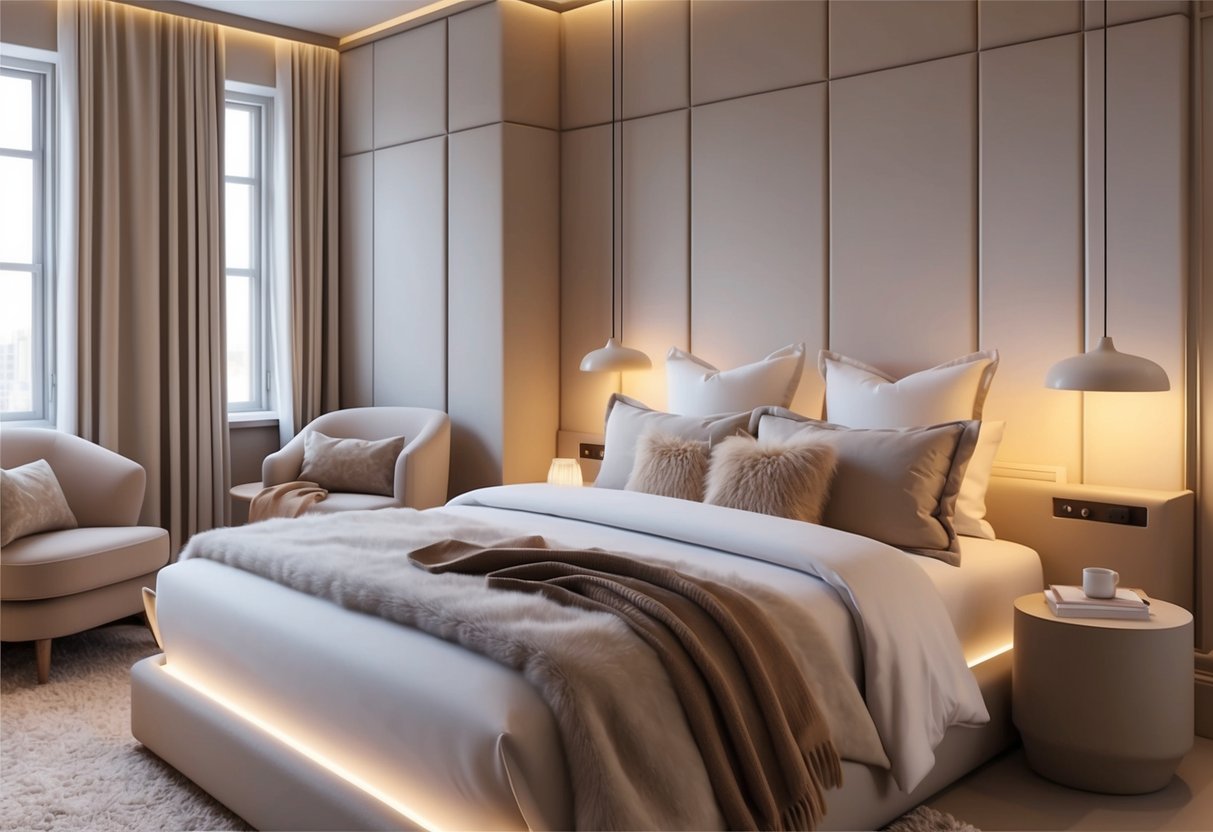
Creating a bedroom that feels both relaxing and peaceful can make a significant difference in daily well-being. A well-designed bedroom retreat starts with soothing colors, decluttered spaces, and elements that promote calm, such as soft lighting, comfortable bedding, and limited technology.
Incorporating thoughtful design choices not only enhances sleep but also transforms the space into a sanctuary for relaxation.
Many people find that simple upgrades like adding air purifying plants, introducing neutral tones, and choosing calming décor help develop an environment that feels inviting and restful. For those seeking inspiration, a variety of approaches—such as using soft, layered textures or arranging furniture for optimal flow—can be found in modern peaceful master bedroom ideas and expert relaxing bedroom tips.
Whether someone is updating an entire master suite or making small changes to a guest room, practical bedroom makeover strategies help create a tranquil retreat to unwind each day.
Designing a Serene Bedroom Retreat
A serene bedroom retreat should blend tranquility with design choices that encourage restful sleep. With intentional details like calming hues and a peaceful sanctuary layout, homeowners can turn any master bedroom into a true escape from daily stress.
Creating a Tranquil Sanctuary
Start by decluttering to remove visual chaos and make the space feel open. Homeowners can use under-bed storage or closed dressers to conceal items and keep surfaces clear.
Incorporate only essential furniture to maximize floor space and foster an uncluttered ambiance. Consider layering soft textiles such as plush area rugs, linen or cotton bedding, and knit throws, as these textures add tactile comfort.
Introduce nature with houseplants like snake plants or peace lilies, which can help purify air and introduce organic tranquility. Adjustable lighting—such as dimmable lamps or soft bedside sconces—allows for glowy ambiance at night and bright energy during the day.
Calming scents from diffusers or candles, such as lavender or chamomile, promote relaxation. For those seeking more inspiration on peaceful room transformations, explore calm bedroom design ideas that showcase how indoor plants and cozy accents contribute to a serene retreat at home: https://www.kingliving.ca/blog/calm-bedroom-design-ideas?srsltid=AfmBOorOUl4Pym6zSs5twAyQj2AESdtxrmN1PCXs1M0_bctaT62cOW2l.
Choosing a Calming Color Palette
The color palette plays a significant role in creating a restful atmosphere. Muted shades like soft blues, gentle greens, and serene grays are known for their soothing effects.
Warm neutrals, such as taupe or ivory, add comfort without visual distraction. Paint walls, ceilings, or trim in these colors, then echo them in bedding, curtains, and rugs.
Avoid bold, bright tones, which can overstimulate and disrupt tranquility. Monochrome or analogous palettes work best for keeping the master bedroom visually cohesive.
Strategically placed accents—such as cushions or abstract art in subdued hues—add harmony. For guidance and examples of calming hues that transform bedrooms into peaceful retreats, see the advice on choosing restful shades for walls and textiles: https://www.homeologyinteriors.com/post/designing-a-relaxing-and-tranquil-bedroom-retreat.
Decluttering and Organization Strategies
Maintaining a tidy bedroom depends on effective strategies for decluttering and organization. Focusing on simplifying belongings and arranging items efficiently creates a calming environment that supports rest and relaxation.
Embracing a Clutter-Free Space
A clutter-free space starts with removing unnecessary items. Sorting personal items into “keep,” “donate,” or “discard” categories can make the decluttering process manageable and less overwhelming.
Containers, baskets, and under-bed storage help store essentials out of sight, keeping surfaces clear and easy to clean. Organizing items by category allows for quick access and prevents accumulation of unused objects.
For example, grouping clothes by season or function and using drawer dividers prevents chaos and saves time. Experts suggest avoiding the urge to only focus on organizing while decluttering; instead, prioritize decisions about what to keep, as highlighted by Clutterbug’s practical advice.
Establishing a routine for decluttering, such as weekly check-ins, helps maintain a clutter-free atmosphere.
Minimalist Aesthetic Principles
The minimalist aesthetic emphasizes simplicity, clean lines, and purposeful design. Limiting décor to a few select pieces helps eliminate visual clutter and allows each element to contribute to the room’s atmosphere.
Neutral colors and subtle textures are often chosen to encourage a sense of peace and spaciousness, inspired by tips like those found at Ducks In A Row Organizers. Choosing multi-functional furniture—like beds with built-in drawers or nightstands with shelves—maximizes storage while minimizing the need for excess items.
Keeping surfaces, such as dressers and nightstands, mostly clear leaves room for only essential or well-loved objects. A minimalist approach not only supports a clutter-free bedroom but can contribute to better mental clarity and an increased sense of tranquility.